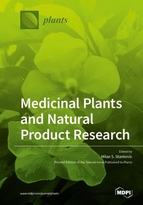Medicinal Plants and Natural Product Research
A special issue of Plants (ISSN 2223-7747).
Deadline for manuscript submissions: closed (30 August 2017) | Viewed by 214000
Special Issue Editor
Interests: plant science; plant biology; plant ecology
Special Issues, Collections and Topics in MDPI journals
Special Issue Information
Dear Colleagues,
For very long time, a large number of plants have been used in medicinal therapy, as well as for food and beverage preparation. Due to their natural origins, the treatment products obtained from medicinal plants are of greater benefit in comparison to synthetic ones. The main carriers of the biological activity of medicinal plants are plant secondary metabolites, as products of a specifically conceived secondary metabolism, which is a continuation of the essential primary metabolism. On the basis of their main roles in plant life, quantitative and qualitative composition of secondary metabolites is in accordance with a variety of environmental influences. In addition to their role in the process of environmental interaction, secondary metabolites from plants express their biological activity in both in vitro and in vivo conditions. Based on these facts, complex studies of medicinal plants, from habitats to the validation of natural products, are interesting for more scientific and practical disciplines. This Special Issue of Plants will contribute to knowledge of medicinal plants from several aspects, such as:
- Morphology and anatomy
- Diversity and phytogeography
- Physiology and ecology
- Methodology of cultivation and collection
- Medicinal plants in traditional and modern folk medicine
- Diversity of plant secondary metabolites
- Methods for quantitative and qualitative analysis of plant secondary metabolites
- Isolation and purification of plant secondary metabolites
- Methods for chemical modification of the active substances from medicinal plants
- In vitro and in vivo biological activity of plant secondary metabolites
Dr. Milan S. Stankovic
Guest Editor
Manuscript Submission Information
Manuscripts should be submitted online at www.mdpi.com by registering and logging in to this website. Once you are registered, click here to go to the submission form. Manuscripts can be submitted until the deadline. All submissions that pass pre-check are peer-reviewed. Accepted papers will be published continuously in the journal (as soon as accepted) and will be listed together on the special issue website. Research articles, review articles as well as short communications are invited. For planned papers, a title and short abstract (about 100 words) can be sent to the Editorial Office for announcement on this website.
Submitted manuscripts should not have been published previously, nor be under consideration for publication elsewhere (except conference proceedings papers). All manuscripts are thoroughly refereed through a single-blind peer-review process. A guide for authors and other relevant information for submission of manuscripts is available on the Instructions for Authors page. Plants is an international peer-reviewed open access semimonthly journal published by MDPI.
Please visit the Instructions for Authors page before submitting a manuscript. The Article Processing Charge (APC) for publication in this open access journal is 2700 CHF (Swiss Francs). Submitted papers should be well formatted and use good English. Authors may use MDPI's English editing service prior to publication or during author revisions.
Keywords
- medicinal plants
- natural products
- ethnobotany
- phytochemistry
- biological effects







